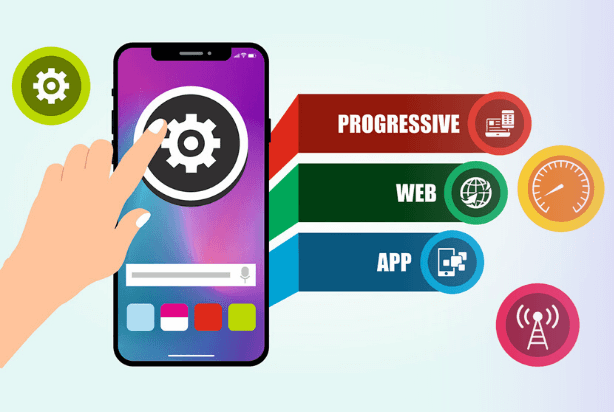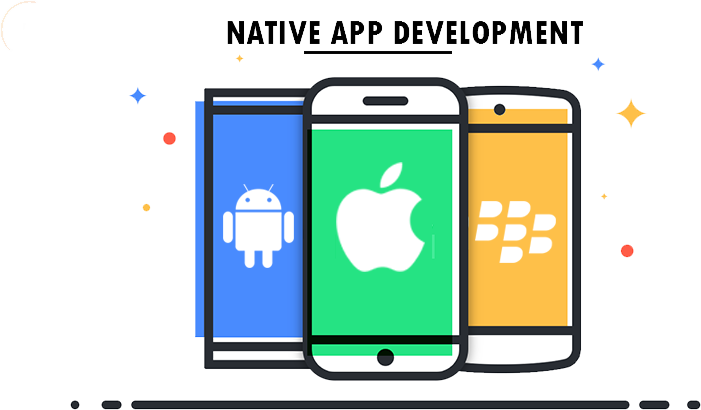
The field of mobile applications is constantly adapting to changing user expectations and technological developments. In this dynamic environment, Progressive Web Apps (PWAs) have become a disruptive force, blurring the lines between traditional websites and traditional apps and offering a unique combination of accessibility, performance, and user experience.
Progressive Web App

So, what exactly are PWAs? At their core, they are web applications Developed using modern web technologies (HTML, CSS, JavaScript), which provides ease of use of the application. Gone are the days of clunky mobile websites.
Native Mobile Apps

Native apps are designed for a specific platform, such as iOS or Android. These apps are installed on your device from the App Store and are designed to take advantage of all the hardware and software features of your device. It is built using programming languages and tools built into the platform and is customised for the capabilities of the specific platform.
Challenges Faced by Native Apps
Common Challenges faced by Native Apps are:
1- Platform Dependency: Applications are always platform dependent, which means they have to be purpose-built for multiple platforms Like iOS and Android. This increases development time and cost and requires specific skills for each platform.
2- Development Cost & Time: Development of traditional applications is generally more expensive and requires more time.
3- App Store Approval Process: Native apps must go through an approval process before being published on the app store. This may result in delays in communicating with you and sending you updates. Violation of App Store policies may result in rejection or removal from the App Store.
4- Installation Hurdles: Users must actively search for existing apps in the app store, download them, and then wait for the installation process to complete. These additional obstacles can prevent users from trying new apps.
5- Storage & Resource Consumption: Apps always use a lot of storage space on the user’s device, especially when they have large files or need frequent updates. They also tend to use more resources like battery life and CPU than PWAs. This increased resource usage can impact the device’s performance and overall user experience. As a result, users may be reluctant to install many traditional apps due to concerns about device storage limitations and other usage restrictions.
6- Internet Connectivity: While some applications are always offline, many rely on an Internet connection for easy use. This can be frustrating for users in regions with poor or no network support.
7- Device Fragmentation: The Android ecosystem is particularly affected by security vulnerabilities due to the number of developers and operating systems used. This isolation makes development and testing difficult, leading to potential social problems.
PWAs: The Alternative Solution
PWA opens a new era. These dynamic changes leverage the power of web technology to bridge the gap between websites and traditional applications, enabling:
1- Responsive: PWAs can be designed to adapt to multiple devices and screens and deliver a great user experience on all sizes, including smartphones, tablets and desktop computers.
2- Offline Resilience: PWA can work even when the internet connection is offline or turned off, by using service providers to store important information and provide offline access to content.
3- App-like Immersion: PWAs are web applications, but they often use an app-like interface with features such as full-screen mode, fluid animations, and navigation that follows native mobile app interfaces.
4- Web-Powered Discoverability: PWA can be searched and shared via URL; allowing users to easily access and share without needing to install from the app store.
5- Trusted & Safe: PWA is served over HTTPS to ensure data integrity and security.
6- Enhanced User Engagement: PWAs support features like push notifications, allowing businesses to interact with users even when they are not actively using the application.
7- Platform-Agnostic Freedom: PWAs are web apps compatible with all devices, including Android, Windows, and Apple/MacOS. Users can easily install and update PWAs on their device’s home screen, providing quick access and a more integrated & seamless experience similar to native apps. No requirement to download and install updates from an app store.
8- Cost-Effective Development: Progressive Web Apps (PWAs) provide a significant advantage in terms of cost-effectiveness and time-effectiveness for business and developers due to cross platform support.
9- Performance & speed: PWAs can offer competitive performance levels because advancements in web technologies have significantly improved PWA performance. PWAs strive to provide a fast and fluid user experience and deliver similar speed and responsiveness by leveraging techniques like pre-fetching resources and utilising browser features for smooth animations.
Impact on Mobile App Development Industry
The emergence of Progressive Web Apps (PWAs) has significantly influenced the mobile app development industry, bringing about several notable changes and trends:
Streamlined Development Processes: PWAs offer a streamlined approach to app development by allowing developers to create a single codebase that can be deployed across multiple platforms and devices. This reduces the time and resources required for development, enabling businesses to bring their apps to market more quickly and efficiently.
Shift in Businesses & Developers Focus: There has been a noticeable shift in focus towards PWAs among businesses and developers. Recognizing the benefits of PWAs, such as improved user experience, broader reach, and reduced development costs, many organisations are prioritising PWA development over native apps. This shift reflects a growing recognition of PWAs as a viable and valuable solution for meeting the demands of modern mobile users.
Team Collaborations: The rise of PWAs has led to increased collaboration between web and app development teams. With PWAs combining the best of both web and app experiences, developers from both domains are coming together to leverage their respective expertise and create innovative solutions. This collaboration ensures that PWAs are well-designed, performant, and capable of delivering a seamless user experience across platforms.
Influence On App Store Ecosystems & Distribution Models: PWAs are reshaping app store ecosystems and distribution models by offering an alternative to traditional app stores. Unlike native apps that rely on app store listings for distribution, PWAs can be accessed directly via the web, bypassing the need for intermediaries. This shift challenges the dominance of app stores and empowers businesses to reach users more directly. Additionally, some app stores are adapting to accommodate PWAs, recognizing their growing importance in the mobile app landscape.
Case Studies & Real-World Examples
Several businesses have successfully implemented PWAs and experienced significant benefits in terms of user engagement, conversion rates, and overall business growth. Here are some notable case studies and examples:
Twitter Lite: In regions with limited internet connectivity, Twitter Lite, a PWA, increased tweet sending by 75%, decreased bounce rate by 20%, and significantly improved overall user engagement.
Starbucks: By implementing a PWA, Starbucks witnessed a 2x increase in daily active users and a 60% increase in user engagement compared to their previous website, demonstrating the power of PWAs in enhancing mobile-first interactions.
Pinterest: Pinterest’s mobile web experience, rebuilt as a PWA, resulted in a 44% increase in user-generated ad revenue and a 40% increase in time spent on the site, highlighting the potential of PWAs to boost user engagement and monetization.
Flipkart: This Indian e-commerce giant saw a 70% increase in conversions, a 3x increase in time spent on site, and a 40% lower bounce rate by adopting a PWA, proving that PWAs can deliver an app-like shopping experience and drive positive business outcomes.
Future Outlook
The future of PWAs is bright, fueled by several key factors:
Future Adoption & Growth:
WAs are set to grow rapidly as businesses see their cost-effectiveness, better user experience, and wider reach. As internet access improves and mobile use increases, PWAs will become vital for meeting mobile users’ needs across industries.
Potential Advancements & Innovations:
Innovations in PWA technology are poised to enhance their capabilities and performance. Progress in web technologies, including new APIs and standards, will enable PWAs to provide more robust features. Better browser support and compatibility will ensure seamless integration across platforms and devices. As PWAs evolve, expect innovations that redefine mobile web development possibilities.
Role in Shaping The Future:
PWAs are set to be pivotal in shaping the future of mobile app development. As businesses prioritise cross-platform compatibility, engagement, and cost-effectiveness, PWAs offer a compelling solution. Their versatility makes them suitable for various applications, from e-commerce to productivity. With the capability to provide app-like experiences on the web, PWAs are poised to become a cornerstone of mobile app development, influencing the industry’s direction for years to come.
Conclusion
PWAs offer the best of both worlds: web accessibility and native app performance. This translates to a lightweight, speedy mobile experience users love, without app store hassle. Plus, PWAs are cost-effective and work across platforms, making them ideal for businesses aiming to expand reach and improve user experience.
They disrupt traditional development with streamlined processes and cross-platform compatibility. Their performance and engagement rival native apps, while offering even greater discoverability and accessibility.
As businesses embrace PWAs, the future of mobile becomes defined by seamless, platform-agnostic experiences. PWAs bridge the web-app gap, driving innovation and shaping the industry’s future.
Published: June 20, 2024










